So Bob wanted a new cruising dinghy, Bill wanted to build a boat, and I wanted to sell this 500th set of plans for John's popular Navigator to someone who would be sure to build the boat. I put the hard sell on Bill, he passed it on to Bob and Bob took the bait.
Bill Tosh is a gifted boat builder, but a man of few words, so I will try to narrate his story by providing captions to the photos.
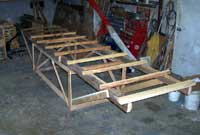 |
This is the strongback that the Nav and most of John Welsford's designs are built on. These boats are normally built right-side-up except for glassing the bottom |
 |
From this angle, you can the curve of the strongback which holds the bottom piece in the proper position. |
|
If you look carefully, you can see that this piece of ply (actually two pieces scarphed together) is marked with the shape of the bottom of the boat. This is the piece that will go on the strongback and on which the rest of the boat will be built. |
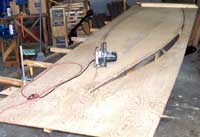 |
I told Bill that this is the 500th Nav and that he better take a lot of pictures. Fortunately, he took me seriously for a change. Here the bottom is about cut out. |
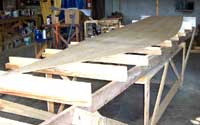 |
And here is the bottom piece in place on the strongback. |
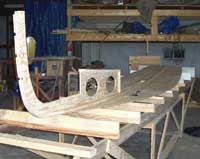 |
Here the stem has been put in place. Just aft of the stem is a web (with lightening holes) that supports the mast in the sloop version of the boat. In the yawl, the main mast would step farther forward and this web would not be necessary. |
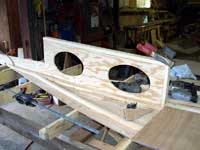 |
Here is a better view of the web. |
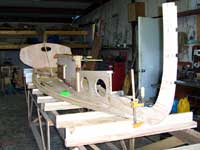 |
The plans allow the builder to choose between a daggerboard and a pivoting centerboard. Bob decided on the latter due to all the 'skinny' water we have around here. |
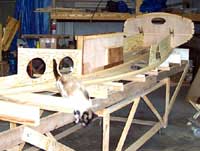 |
Bill just barely caught this picture of the construction supervisor before he jumped down. |
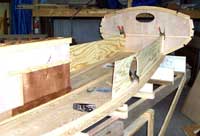 |
The pieces on either side of the centerboard trunk are the seat risers. They will form watertight compartments that will add a considerable safety factor to the boat. |
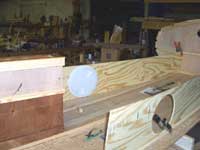 Bill took a minute to make the following statement: Bill took a minute to make the following statement:
"You can't tell from the pics, but almost nothing is "attached" YET.This is one of the things that I do in the process of boat building. At this stage of the game, I don't "attach" anything until I am SURE that I am ready to install the stringers, then after triple checking, I go back to the plans one last time to see if I can catch anything that I may have missed."
"It is a lot easier to make corrections without having to 'tear things apart'. I try to go as far as I can without glue, screw or whatever, THEN once satisfied that I'm OK so far, I disassemble everything and install each component in order. Things fit up better and stronger."
"The deckplate is just wedged in the hole so you could see what it will look like. Those will most likely be one of the last things attached." |

